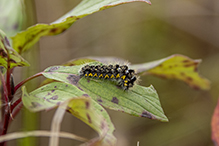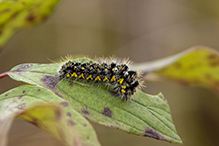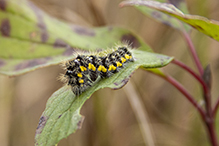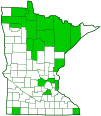Smeared dagger
(Acronicta oblinita)
Conservation • Description • Habitat • Ecology • Distribution • Taxonomy
| Hodges # | 9272 |
||
Conservation Status |
|||
| IUCN Red List | not listed |
||
| NatureServe | N5 - Secure |
||
| Minnesota | not listed |
||
Description |
Smeared dagger is a medium-sized, widespread but uncommon dagger moth. It occurs in the United States east of the Great Plains and in adjacent Canadian provinces, with a separate population in Alberta, and a handful of records on the West Coast. It is uncommon throughout its range. In Minnesota it is more common in the north, less common in the south. It is found in open woodlands, woodland edges, meadows, bogs, and wetlands. Adults are ¾″ to 1⅛″ (20 to 28 mm) long and have a wingspan of 1 7 ⁄16″ to 2⅛″ (36 to 54 mm). The forewings are long, narrow, pale to medium gray, dull, and heavily marked with obscure, dark gray streaks. They are longer and narrower, and have less sharply defined markings, than other North American dagger moths. There is a circular spot (orbicular spot) in the upper median area and a kidney-shaped (reniform spot) spot at the end of the discal cell. The orbicular spot is a thin dark circle. It is usually incomplete, open at the top and bottom. The reniform spot also has an incomplete dark outline and is usually slightly darker than the background color. There are indistinct, strongly jagged, antemedial (AM) and postmedial (PM) lines. The PM line is accented with a row of dark triangles. The terminal line consists of a series of conspicuous black spots between the veins. The hindwings are white with a terminal line of black spots between the veins. The caterpillar is known as the smartweed caterpillar. However, it is a generalist, feeding on a wide range of forbs, shrubs, and trees. It also feeds on agricultural crops, where it can cause defoliation and is considered a pest. The late stage (instar) caterpillar is up to 1 9 ⁄16″ (4 cm) long and is highly variable in color. It is usually mostly black. The breathing pores (spiracles) are white and there is a large, bright yellow, inverted V-shaped blotch between the spiracles. There are numerous tufts of mostly equal-length, bristle-like hairs (setae) on raised warts on each thoracic and abdominal segment. On some individuals the warts are reddish. The hairs are irritating (urticating), and will cause a stinging sensation if the caterpillar is handled. There are sometimes white spots in the subdorsal area, and they sometimes coalesce into a stripe. Mature caterpillars are found from May through November. |
Size |
Total length: ¾″ to 1⅛″ (20 to 28 mm) Wingspan: 1 7 ⁄16″ to 2⅛″ (36 to 54 mm) |
Similar Species |
Habitat and Hosts |
Open woodlands, woodland edges, meadows, bogs, wetlands |
Ecology |
Season |
One generation per year in Minnesota: May through July |
Behavior |
Adults are active at night and will come to lights. |
Life Cycle |
Pupa overwinter |
Larva Hosts |
Many forbs, shrubs, trees, and grasses, including clover, corn, smartweed, strawberry, fireweed, cattail, alder, apple, birch, aspen, elm, oak, willow, and pine. |
Adult Food |
|
Distribution |
||
|
Sources 7, 21, 27, 29, 30, 71, 75, 82, 83. Biodiversity occurrence data published by: Minnesota Biodiversity Atlas (accessed through the Minnesota Biodiversity Atlas Portal, bellatlas.umn.edu, 8/29/2025). |
|
| 8/29/2025 | ||
Occurrence |
||
|
||
Taxonomy |
|
Order |
|
Superfamily |
Noctuoidea (Owlet Moths and Allies) |
Family |
Noctuidae (cutworm moths and allies) |
Subfamily |
Acronictinae |
Genus |
Acronicta (dagger moths) |
Subgenus |
Simyra |
Section |
Acronicta lupini (lupine and smeared daggers and allies) |
Subordinate Taxa |
|
|
|
Synonyms |
|
Acronicta arioch Acronicta insolita Acronicta salicis Oligia arioch Oligia oblinita |
|
Common Names |
|
smartweed caterpillar (larva) smeared dagger smeared dagger moth |
|
Glossary
Instar
The developmental stage of arthropods between each molt; in insects, the developmental stage of the larvae or nymph
Orbicular spot
A circular spot or outline in the upper median area near the antemedial line on the forewing of many moths.
Reniform spot
A kidney-shaped spot or outline in the lower median area near the PM line on the forewing of many moths.
Seta
A stiff, hair-like process on the outer surface of an organism. In Lepidoptera: A usually rigid bristle- or hair-like outgrowth used to sense touch. In mosses: The stalk supporting a spore-bearing capsule and supplying it with nutrients. Plural: setae. Adjective: setose.
Visitor Photos |
Share your photo of this insect. |
||
This button not working for you? |
||
|
||
MinnesotaSeasons.com Photos |
 |
 |
|
 |

Slideshows |
|

Visitor Videos |
Share your video of this insect. |
||
This button not working for you? |
||
|
Other Videos |
Smeared Dagger Moth Caterpillar (Noctuidae: Acronicta oblinita?) on Leaf |
About
Aug 9, 2010 Photographed at the Agassiz NWR, Minnesota (02 August 2010). Thank you to John and Jane Balaban (@Bugguide.net) for identifying this specimen! |

Visitor Sightings |
Report a sighting of this insect. |
||
This button not working for you? |
||
|
|
MinnesotaSeasons.com Sightings |

|
Created: 10/23/2019 Last Updated: © MinnesotaSeasons.com. All rights reserved. |
